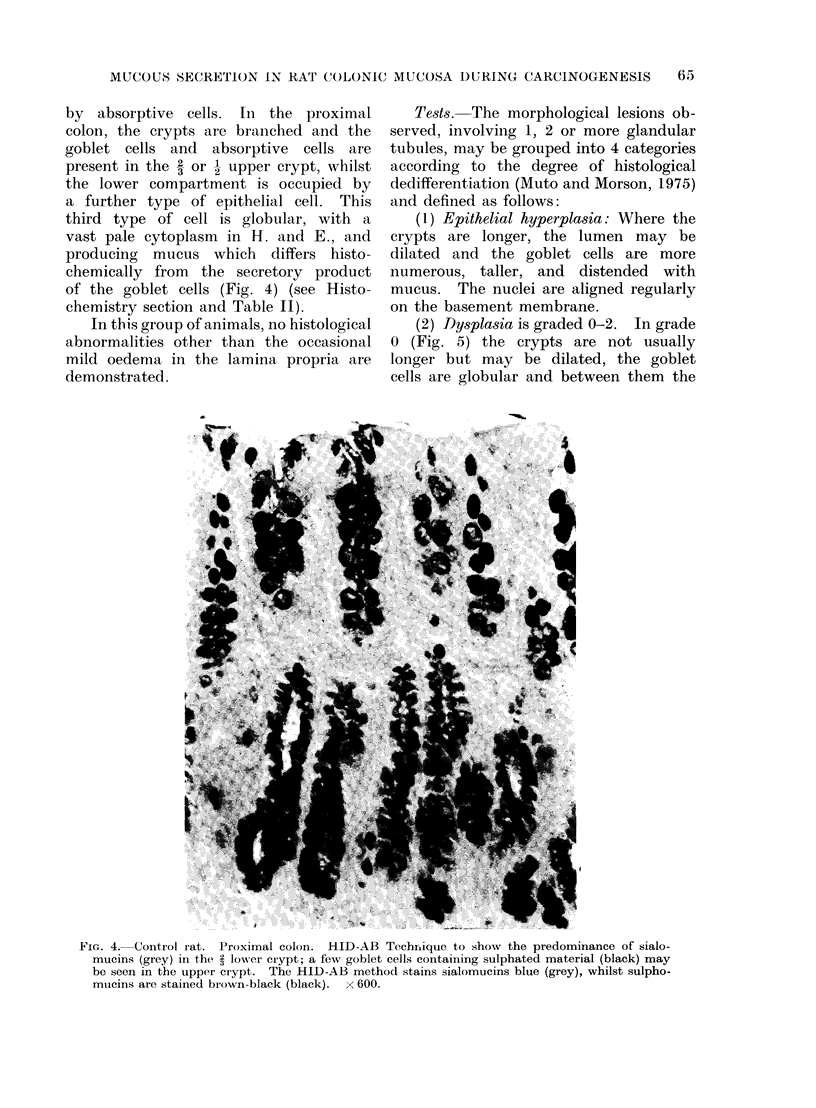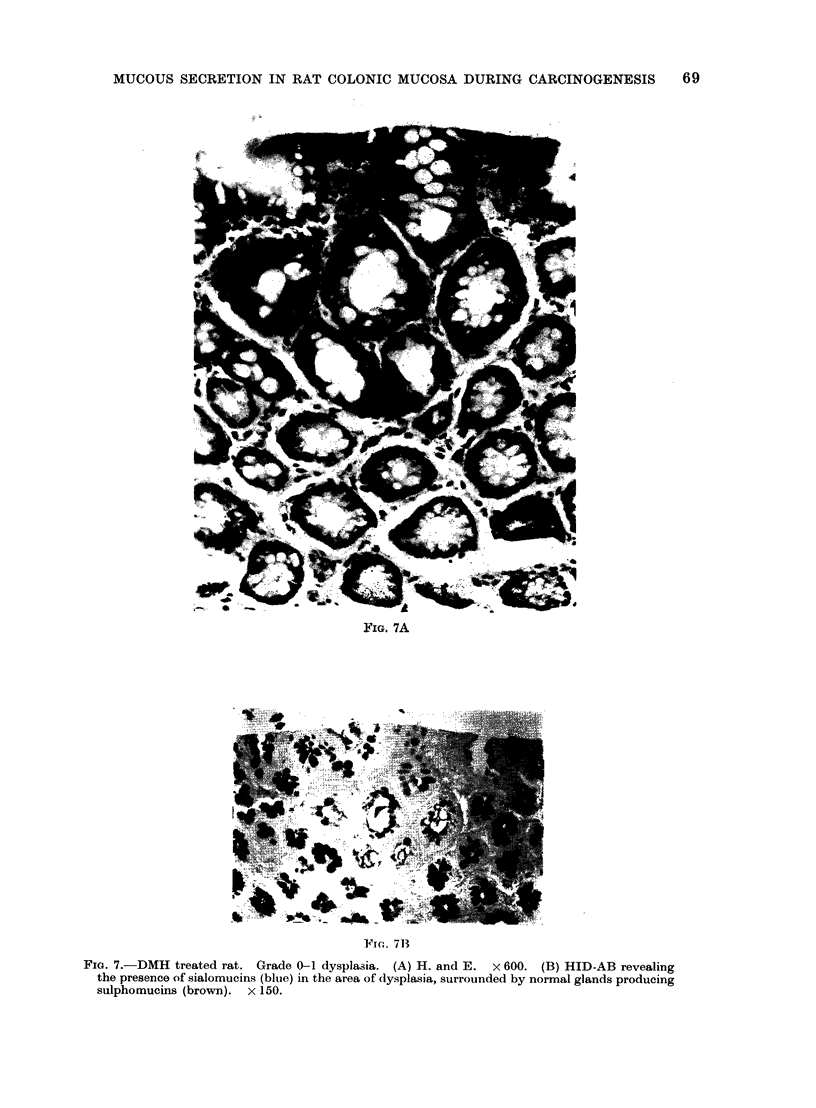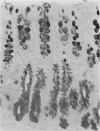Abstract
Our previous studies, in specimens of large intestine resected for carcinoma, have shown abnormal patterns of mucous secretion in areas of apparently "normal" mucosa, where goblet cells produce mainly sialomucins as compared with the true normal colonic mucosa in which sulphomucins predominate. In the present work, large bowel cancer was induced in rats by the administration of 1,2-dimethylhydrazine-2HCl (DMH). We attempted to study the sequential histological and secretory abnormalities which developed in the colonic epithelium during carcinogenesis, and to correlate these changes with those described above in the human. The microscopical and histological lesions observed in the colonic mucosa of DMH treated rats confirmed the findings of other authors and resembled the human colorectal cancer. The earliest changes detected were small foci of hyperplasia accompanied from the 6th week onwards by several foci of dysplasia. Carcinoma in situ appeared at the 15th week and finally invasive carcinoma developed from the 19th week onwards. Changes in the type of mucous secretion, with predominance of sialomucins, were observed in the majority of the areas showing mild to moderate dysplasia whilst the surrounding normal epithelium produced suphated material. Mucous depletion was a common feature in areas of severe dysplasia and carcinoma. These findings correlated well with the similar variations in the mucin composition observed in human colonic mucosa in carcinoma and further supported our previous hypothesis that mucin changes characterized by an increase in sialomucins might reflect early malignant transformation. If this hypothesis proved to be correct, the use of a simple method for the identification of mucins in large bowel biopsies would be of great help in detecting early malignancy.
Full text
PDF

















Images in this article
Selected References
These references are in PubMed. This may not be the complete list of references from this article.
- Baldwin R. W. Tumour specific antigens associated with chemically induced tumours. Rev Eur Etud Clin Biol. 1970 Jun-Jul;15(6):593–598. [PubMed] [Google Scholar]
- Bordes M., Michiels R., Martin F. Detection by immunofluorescence of carcinoembryonic antigen in colonic carcinoma, other malignant or benign tumours, and non-cancerous tissues. Digestion. 1973;9(2):106–115. doi: 10.1159/000197436. [DOI] [PubMed] [Google Scholar]
- Currie G. A., Bagshawe K. D. The role of sialic acid in antigenic expression: further studies of the Landschütz ascites tumour. Br J Cancer. 1968 Dec;22(4):843–853. doi: 10.1038/bjc.1968.99. [DOI] [PMC free article] [PubMed] [Google Scholar]
- Deman J. J., Bruyneel E. A., Mareel M. M. A study on the mechanism of intercellular adhesion. Effects of neuraminidase, calcium, and trypsin on the aggregation of suspended HeLa cells. J Cell Biol. 1974 Mar;60(3):641–652. doi: 10.1083/jcb.60.3.641. [DOI] [PMC free article] [PubMed] [Google Scholar]
- Deschner E. E., Lipkin M. Study of human rectal epithelial cells in vitro. III. RNA, protein, and DNA synthesis in polyps and adjacent mucosa. J Natl Cancer Inst. 1970 Jan;44(1):175–185. [PubMed] [Google Scholar]
- Emmelot P. Biochemical properties of normal and neoplastic cell surfaces; a review. Eur J Cancer. 1973 May;9(5):319–333. doi: 10.1016/0014-2964(73)90047-9. [DOI] [PubMed] [Google Scholar]
- Farber E. Biochemistry of carcinogenesis. Cancer Res. 1968 Sep;28(9):1859–1869. [PubMed] [Google Scholar]
- Filipe M. I. 35 sulphur uptake in the mucosa adjacent to carcinoma of the large intestine. Histochem J. 1971 Jan;3(1):27–35. doi: 10.1007/BF01686504. [DOI] [PubMed] [Google Scholar]
- Filipe M. I., Branfoot A. C. Abnormal patterns of mucus secretion in apparently normal mucosa of large intestine with carcinoma. Cancer. 1974 Aug;34(2):282–290. doi: 10.1002/1097-0142(197408)34:2<282::aid-cncr2820340211>3.0.co;2-w. [DOI] [PubMed] [Google Scholar]
- Filipe M. I., Cooke K. B. Changes in composition of mucin in the mucosa adjacent to carcinoma of the colon as compared with the normal: a biochemical investigation. J Clin Pathol. 1974 Apr;27(4):315–318. doi: 10.1136/jcp.27.4.315. [DOI] [PMC free article] [PubMed] [Google Scholar]
- Filipe M. I. Value of histochemical reactions for mucosubstances in the diagnosis of certain pathological conditions of the colon and rectum. Gut. 1969 Jul;10(7):577–586. doi: 10.1136/gut.10.7.577. [DOI] [PMC free article] [PubMed] [Google Scholar]
- GOLD P., FREEDMAN S. O. DEMONSTRATION OF TUMOR-SPECIFIC ANTIGENS IN HUMAN COLONIC CARCINOMATA BY IMMUNOLOGICAL TOLERANCE AND ABSORPTION TECHNIQUES. J Exp Med. 1965 Mar 1;121:439–462. doi: 10.1084/jem.121.3.439. [DOI] [PMC free article] [PubMed] [Google Scholar]
- Gad A., Sylvén B. On the nature of the high iron diamine method for sulfomucins. J Histochem Cytochem. 1969 Mar;17(3):156–160. doi: 10.1177/17.3.156. [DOI] [PubMed] [Google Scholar]
- Haase P., Cowen D. M., Knowles J. C., Cooper E. H. Evaluation of dimethylhydrazine induced tumours in mice as a model system for colorectal cancer. Br J Cancer. 1973 Dec;28(6):530–543. doi: 10.1038/bjc.1973.183. [DOI] [PMC free article] [PubMed] [Google Scholar]
- Imondi A. R., Balis M. E., Lipkin M. Changes in enzyme levels accompanying differentiation of intestinal epithelial cells. Exp Cell Res. 1969 Dec;58(2):323–330. doi: 10.1016/0014-4827(69)90512-6. [DOI] [PubMed] [Google Scholar]
- Lev R., Orlic D. Histochemical and radioautographic studies of normal human fetal colon. Histochemistry. 1974 Jun 5;39(4):301–311. doi: 10.1007/BF00495681. [DOI] [PubMed] [Google Scholar]
- Mian N., Cowen D. M. Glycosidases in normal and dimethylhydrazine-treated rats and mice with special reference to the colonic tumours. Br J Cancer. 1974 Jun;29(6):438–446. doi: 10.1038/bjc.1974.96. [DOI] [PMC free article] [PubMed] [Google Scholar]
- Mian N., Cowen D. M., Nutman C. A. Glycosidases heterogeneity among dimethylhydrazine induced rat colonic tumours. Br J Cancer. 1974 Sep;30(3):231–237. doi: 10.1038/bjc.1974.186. [DOI] [PMC free article] [PubMed] [Google Scholar]
- Miller E. C., Miller J. A. Mechanisms of chemical carcinogenesis: nature of proximate carcinogens and interactions with macromolecules. Pharmacol Rev. 1966 Mar;18(1):805–838. [PubMed] [Google Scholar]
- Rios A., Simmons R. L. Immunospecific regression of various syngeneic mouse tumors in response to neuraminidase-treated tumor cells. J Natl Cancer Inst. 1973 Aug;51(2):637–644. [PubMed] [Google Scholar]
- SPICER S. S. DIAMINE METHODS FOR DIFFERENTIALING MUCOSUBSTANCES HISTOCHEMICALLY. J Histochem Cytochem. 1965 Mar;13:211–234. doi: 10.1177/13.3.211. [DOI] [PubMed] [Google Scholar]
- Shank R. C., Magee P. N. Similarities between the biochemical actions of cycasin and dimethylnitrosamine. Biochem J. 1967 Nov;105(2):521–527. doi: 10.1042/bj1050521. [DOI] [PMC free article] [PubMed] [Google Scholar]
- Smith B., Butler M. The autonomic control of colonic mucin secretion in the mouse. Br J Exp Pathol. 1974 Dec;55(6):615–621. [PMC free article] [PubMed] [Google Scholar]
- Sorvari T. E. Histochemical observations on the role of ferric chloride in the high-iron diamine technique for localizing sulphated mucosubstances. Histochem J. 1972 May;4(3):193–204. doi: 10.1007/BF01890991. [DOI] [PubMed] [Google Scholar]
- Springer P., Springer J., Oehlert W. Die Vorstufen des 1,2-Dimethylhydrazin-induzierten Dick- und Dünndarmcarcinoms der Ratte. Z Krebsforsch. 1970;74(3):236–240. [PubMed] [Google Scholar]
- Stonehill E. H., Bendich A. Retrogenetic expression: the reappearance of embryonal antigens in cancer cells. Nature. 1970 Oct 24;228(5269):370–372. doi: 10.1038/228370a0. [DOI] [PubMed] [Google Scholar]
- Thurnherr N., Deschner E. E., Stonehill E. H., Lipkin M. Induction of adenocarcinomas of the colon in mice by weekly injections of 1,2-dimethylhydrazine. Cancer Res. 1973 May;33(5):940–945. [PubMed] [Google Scholar]
- Troncale F., Hertz R., Lipkin M. Nucleic acid metabolism in proliferating and differentiating colonic cells of man and in neoplastic lesions of the colon. Cancer Res. 1971 Apr;31(4):463–467. [PubMed] [Google Scholar]
- Ward J. M. Morphogenesis of chemically induced neoplasms of the colon and small intestine in rats. Lab Invest. 1974 Apr;30(4):505–513. [PubMed] [Google Scholar]
- Warren L., Fuhrer J. P., Buck C. A. Surface glycoproteins of normal and transformed cells: a difference determined by sialic acid and a growth-dependent sialyl transferase. Proc Natl Acad Sci U S A. 1972 Jul;69(7):1838–1842. doi: 10.1073/pnas.69.7.1838. [DOI] [PMC free article] [PubMed] [Google Scholar]
- Wiebecke B., Löhrs U., Gimmy J., Eder M. Erzeugung von Darmtumoren bei Mäusen durch 1,2-Dimethylhydrazin. Z Gesamte Exp Med. 1969;149(3):277–278. [PubMed] [Google Scholar]
- von Kleist S., Burtin P. Isolation of a fetal antigen from human colonic tumors. Cancer Res. 1969 Nov;29(11):1961–1964. [PubMed] [Google Scholar]
- von Kleist S. Etude d'un antigène spécifique de tumeurs coliques humaines d'origine embryonnaire. Biol Med (Paris) 1971 May-Jun;60(3):237–292. [PubMed] [Google Scholar]













